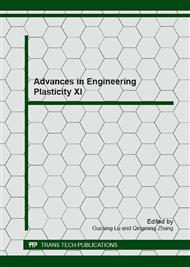p.239
p.243
p.247
p.250
p.254
p.263
p.267
p.271
p.275
Deformation Behavior and Formability of Sheet Metal Laminate Consisting of Perforated Core Sheet and Thin Skin Sheets
Abstract:
This study presents a new type of sheet metal laminate for lightweight products, and investigates its plastic behavior and formability. The sheet metal laminate consists of three layers, i.e. two thin skin sheets and a perforated core sheet with round holes, which are bonded together by diffusion bonding. Pure copper sheets are used for both of the core and the skins. Plastic deformations of the laminate and its component layers under uniaxial and biaxial tension are examined experimentally and analytically. Results of uniaxial stress-strain responses and yield loci (contours of plastic work) show that the perforated core sheet exhibits anisotropic behavior induced by the hole array but the laminated sheet becomes rather isotropic. Forming limit diagrams of the laminate and its component layers are also obtained by performing stretch forming test. Forming limit of the perforated core sheet is markedly lower than that of the monolithic sheet, and that of the thin skin is in between. It is found that forming limit of the laminate is comparable to that of the thin skin.
Info:
Periodical:
Pages:
254-257
Citation:
Online since:
January 2013
Authors:
Price:
Сopyright:
© 2013 Trans Tech Publications Ltd. All Rights Reserved
Share:
Citation:


